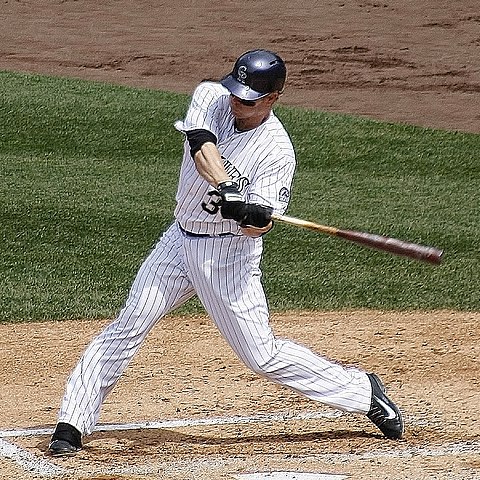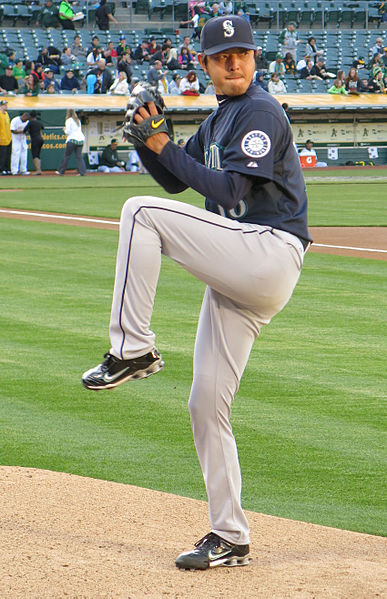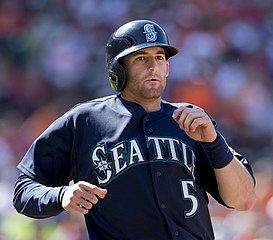 |
| Justin Morneau (William Andrus, UCinternational: Wikimedia Commons) |
Jerry Dipoto has publicly stated that the Mariners are done making major moves. With that said, there are many decent free agents remaining with only so much time and so many roster spots up for grabs. It seems likely that somebody who could be valuable to the Mariners can be found for cheap - perhaps even as a non-roster invitee signing.
Fangraphs has a helpful sorter that lists remaining free agents with projected 2016 WAR totals. I have split the free agents into three major groups - up the middle defenders, corner defenders, and pitchers. Within those groups I stratified them by projected WAR total for 2016.
Obviously, the best players would help the Mariners most, but I am assuming that the Mariners have little to no money left and largely an interest in bolstering depth. The question is which players as free agents could bolster the Mariners and be interested in a supporting role. I have highlighted my best guesses as good fits in each group:
Second base, shortstop, center field
- 2 WAR: Howie Kendrick (2.6), Denard Span (2.4)
- 1 WAR: Dexter Fowler (1.7), Ian Desmond (1.5), Austin Jackson (1.4), Jimmy Rollins (1.4)
- 0 WAR: Alexei Ramirez (0.8)
The Mariners look quite good up the middle of their infield thanks to the presence of both Chris Taylor and Shawn O'Malley. Taylor may not have hit much in the majors (yet) but his glove is good enough to make him a capable starter for many teams. It is good the Mariners already have infield depth because the free agent market has little to offer up the middle defensively.
However, another player who can patrol center field would sure be handy. Leonys Martin is the everyday man, but what if he does not hit again? Or gets injured?
Austin Jackson could, ironically, be a fit. He would certainly be nice to have as a reserve, given his solid defense, good speed, and youthful age (still just 28, which is young for a free agent).
The real question is if the Mariners are a good fit for Jackson. Ultimately, I doubt it, but the market for center fielders seems tepid at best for now. It could make some sense for Jackson to accept a one-year deal somewhere he thinks he can carve out playing time before trying free agency again. If there are few offers for Jackson and he thinks the Mariners offer the best chance at playing time, perhaps he bites.
First base, third base, left field, right field
- 3 WAR: Alex Gordon (3.5)
- 2 WAR: Yoenis Cespedes (2.9), Justin Upton (2.8), Juan Uribe (2.4), Chris Davis (2.3), Steve Pearce (2.0)
- 1 WAR: David Freese (1.4), Gerardo Parra (1.0)
- 0 WAR: Justin Morneau (0.8), Shane Victorino (0.8), Matt Joyce (0.8), Ryan Raburn (0.8), Will Venable (0.5), Kelly Johnson (0.4), David Murphy (0.2), Chris Denorfia (0.1), Marlon Byrd (0.1)
The Mariners largely filled their first base hole when they signed Adam Lind but he could use a platoon partner to face lefties. Jesus Montero could be that answer but I would still be monitoring the free agent market if I was Jerry Dipoto. Justin Morneau, believe it or not, has run a reverse platoon split for his career! He is better against lefties and still hits pretty well when healthy. His age and health concerns likely limit his market. He could be a good fit in Seattle, where he would not be expected to play every day but could help the lineup stay strong if Lind or Nelson Cruz goes down with an injury for some time.
Steve Pearce intrigues me the most though. Projection systems really like him. He doesn't fit the Dipoto mold perfectly - he strikes out a ton and does not have great on-base skills - but he has power and struggled last year thanks largely to a bad BABIP rate. He is a strong candidate for a rebound. Moreover, he has experience playing both first base and left field, and he rates as a passable defender in the outfield according to the stats. I don't know what kind of market has developed around him, but he could be a steal as a non-roster invitee. Seattle would have to be an intriguing place to him because there is a clear path to playing time for him as Lind's platoon partner and the chance to slide into the outfield rotation if any of the current quartet (Smith, Gutierrez, Martin, Aoki) goes down with an injury.
I highlighted Kelly Johnson for similar reasons, minus the bullish projection. He would be passable depth, but he has already transitioned into a reserve role. He would seem to be open to that again.
Will Venable and Shane Victorino could both provide potential outfield depth. Venable in particular seems like a great fit because he could slide over to center and be passable. Victorino has a similar skillset but is much older and would have to accept a reserve role. He would essentially have to be willing to take the route of Franklin Gutierrez, and he would be Guti's replacement if Guti were to get injured. Those are big 'if's.
Pitchers
- 3 WAR: Cliff Lee (3.3), Wei-Yin Chen (3.0)
- 2 WAR: Scott Kazmir (2.8), Josh Johnson (2.8), A.J. Burnett (2.5), Ian Kennedy (2.3), Brandon Morrow (2.2), Mat Latos (2.1)
- 1 WAR: Yovani Gallardo (1.9), Mark Buehrle (1.6), Doug Fister (1.5), Alfredo Simon (1.1), Edwin Jackson (1.0)
- 0 WAR: Aaron Harang (0.9), Tim Lincecum (0.9), Kyle Lohse (0.9), Chad Billingsley (0.8), Joe Blanton (0.7), Ross Ohlendorf (0.6), Jeremy Guthrie (0.6), Jeff Francis (0.5), Tommy Hunter (0.4), Antonio Bastardo (0.4), Fernando Rodney (0.4), Gavin Floyd (0.4), Chris Capuano (0.3), Matt Thornton (0.3), Manny Parra (0.3), Matt Albers (0.3), Neal Cotts (0.2), Ryan Webb (0.2), Randy Choate (0.2), Carlos Villanueva (0.2), Joe Nathan (0.2), Tom Gorzelanny (0.1), Peter Moylan (0.1), Tyler Clippard (0.1), Eric O'Flaherty (0.0), Blaine Boyer (0.0), Franklin Morales (0.0), Matt Belisle (0.0)
No team can have too much pitching. I expect all of these pitchers to sign before the season starts, though it would be reasonable to guess that many of these pitchers will be choosing which team to accept a non-roster spring training invite from. The Mariners are probably not an enticing fit from a non-roster standpoint because the rotation already has six capable arms. However, Safeco's spacious dimensions is also the kind of locale that could allow a pitcher to recover some value and try to get a bigger deal next offseason.
If the Mariners want to go after a reclamation project, Josh Johnson and Brandon Morrow fit the mold. Both have power arms and both have broken down over the past few seasons. A transition to full-time bullpen work might make sense for both of them. Morrow has already experienced success in the bullpen, albeit early in his career.
Players with connections to the northwest are always fun to speculate about too. Both Doug Fister and Tim Lincecum could be looking for places to rebound and would make for fun stories if signed by the Mariners.
Now, on to the most realistic options. Tommy Hunter has been a quietly effective reliever the past three seasons, though he took a step back in 2015. However, he possesses a huge fastball that averages over 96 MPH out of the bullpen, and he has some command of it. You would expect more strikeouts from such a big arm, but the results are still solid and he largely fits the mold of a Dipoto pitcher. It's easy to imagine him in middle relief for a Dipoto team and he could get lost in the free agency shuffle. Another big arm that might be had on a non-roster invitee deal is Fernando Rodney. Snicker all you want, but he could be interesting on a non-guaranteed deal.
Manny Parra and Carlos Villanueva both have experience starting in their past with at least decent results. They have also experienced success in the bullpen. Parra throws harder than Villanueva so seems like the better fit for Dipoto's style, but both could be the type of solid innings absorbers that keep quality arms from getting overused.
The next few weeks could be indirectly interesting for the Mariners. They hardly seem in position to pursue anyone, but a handful of players are going to lose out in the game of musical chairs that is MLB free agency. A player or two who could be of surprising value to the Mariners might slip through the cracks and be had for a price that fits the Mariners budget at this point.






